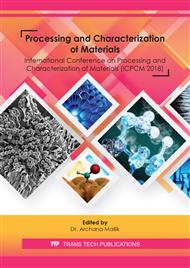p.291
p.296
p.304
p.311
p.316
p.323
p.330
p.337
p.344
The Influence of Moisture Absorption on the Mechanical and Thermal Properties of Chemically Treated DPL Reinforced Hybrid Composite
Abstract:
Moisture absorption of natural fiber-based composites is one of the major problems in outdoor applications. The present study deals with the effect of moisture absorption on mechanical and thermal properties of unmodified/modified Date Palm Leaf (DPL) with glass fiber-based hybrid composites. Natural fibers were modified with alkaline treatment to improve fiber and matrix bonding. Conventional hand lay-up technique is used to fabricate the composites with varying different wt.% of treated and untreated short DPL with constant wt.% of glass fiber and prepared with random oriented manner. The combine effect of hydrophilic and hydrophobic nature find out as the study based upon the natural with synthetic fiber hybrid composites. Mechanical behaviour of the epoxy-based hybrid composites were characterized by using tensile, flexural and hardness test. The results revealed that significant improvement in mechanical properties by the addition of different weight percentage of modified DPL. Different thermal properties of the composites were described by using Thermo Gravimetric Analyzer (TGA) and Differential Scanning Calorimetric (DSC). Morphological investigation was carried out to by using scanning electron microscope. All the properties of untreated natural fiber reinforced composites were mostly affected by the influence of water absorption as compared with chemically treated based composites.
Info:
Periodical:
Pages:
316-322
Citation:
Online since:
February 2020
Price:
Сopyright:
© 2020 Trans Tech Publications Ltd. All Rights Reserved
Share:
Citation:


